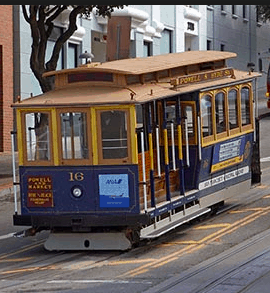Last week my husband and I flew to San Francisco, into that rarefied air that can only be California. Our first stop was San Francisco, or the polyglot that columnist Herb Caen used to call Baghdad by the Bay (back when Baghdad had a romantic aura about it). As we traveled around the city, several First Women asserted themselves into my reflections —as strong women are wont to do.
On our way to Grace Cathedral, where we are always rewarded with inspiration, we walked to the cable car waiting only a few blocks from our hotel. Little did I know that inspiration would strike even before we reached the Church. We secured a seat on the cable car, relatively easy to do on a Sunday morning outside of tourist season. The iron bar that reaches down to clamp the ever-rotating cable, giving the cable car conductor control over when the car halts and lurches forward, was only a few feet from my own hands. The wooden handle was polished from years of firm grips and I could almost see Maya Angelou, the first black woman to be a San Francisco streetcar conductor. I could visualize that determined young woman gripping the wooden handle with her gloved hand, and almost certainly greeting her riders as they jumped on board.

Later, on a bus tour of the city with my brother and sisters, who had joined us in “The City,” we passed City Hall.The guide did not comment on its grizzly history, when Dan White entered the building and assassinated gay activist and city supervisor Harvey Milk, as well as Mayor George Moscone. This tragedy elevated Dianne Feinstein to the position of Mayor—the First Woman Mayor of San Francisco. (Feinstein later became the First Woman Senator from California.)
 My siblings, my husband and I sailed out to Alcatraz, that infamous prison of book and lore. The tour of the prison, narrated on an audiotape by a former warden, was sobering, but the history of Alcatraz is more than the history of a prison. The ruins of an old fort still hold fast to the hillside and remnants of the Native American occupation of the abandoned island in 1969 still demonstrate tribal efforts to be heard and honored. Pictures of the occupation reminded me of Wilma Mankiller who visited the island frequently, worked in the San Francisco command post, and raised money for the cause of respecting treaty rights. She wrote in her biography that the people she met there had “major and enduring effects on me.” The lessons she learned during that nineteen months put her on the road to the position of First Woman chief of the Cherokee Nation.
My siblings, my husband and I sailed out to Alcatraz, that infamous prison of book and lore. The tour of the prison, narrated on an audiotape by a former warden, was sobering, but the history of Alcatraz is more than the history of a prison. The ruins of an old fort still hold fast to the hillside and remnants of the Native American occupation of the abandoned island in 1969 still demonstrate tribal efforts to be heard and honored. Pictures of the occupation reminded me of Wilma Mankiller who visited the island frequently, worked in the San Francisco command post, and raised money for the cause of respecting treaty rights. She wrote in her biography that the people she met there had “major and enduring effects on me.” The lessons she learned during that nineteen months put her on the road to the position of First Woman chief of the Cherokee Nation.
As I flew away from “The City,” and back to my writing, I wondered how many other First Women it had produced.
Afterthought: This site is about First Women, but one statement on a display at Alcatraz caught my eye and pricked my focus on First Women for a moment. Frank Weatherman, known as AZ 1576, was the Last Man to leave Alcatraz. “Alcatraz was never no good for nobody,” he said on the occasion.

